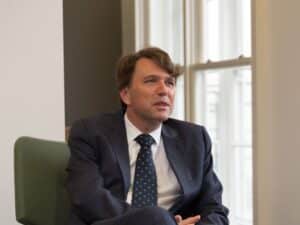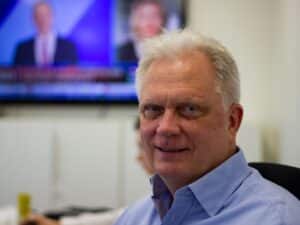Stockholm (HedgeNordic) – Stop-loss orders are an essential piece in the trading strategy and risk management design of many quantitative, trend-based investment approaches. “Stop losses are crucial to protecting investor capital,” Patrik Säfvenblad, CIO at Volt Diversified Alpha, claims, for instance.
“The market is always right,” suggests Säfvenblad. “If we lose money, markets know something we do not, and it is natural to reduce positions in response,” says the CIO of the Swedish fundamentals-based systematic fund that was named the “Best Nordic CTA” of 2020. Stop-loss orders can minimize the downside and, more importantly, set the stage for securing the upside. “We trade a diversified portfolio, so stop losses also come with the benefit of freeing up risk capital to be used in markets with better risk-reward,” emphasizes Säfvenblad.
“Stress scenarios typically offer good opportunities for fundamental trading, so freeing up risk capital from losing positions allows us to enter new signals in other markets.”

“Stop-losses primarily protect against stress scenarios such as a sudden equity crash,” elaborates Säfvenblad. “In those periods, stop losses are crucial.” But these stress scenarios also create attractive risk-reward opportunities for the diversified, fundamental macro manager that uses machine learning and fundamental data to capture price moves across various markets. “Stress scenarios typically offer good opportunities for fundamental trading, so freeing up risk capital from losing positions allows us to enter new signals in other markets,” says Säfvenblad.

Stop losses have similar strategic and practical implications for Karl Oscar Strøm, who uses technical and quantitative analysis to run his Paleo Fund. “One can separate between downsides and strategic and practical implications,” Strøm tells HedgeNordic. “A stop loss is intended to take you out of a position, and the tighter the stop, the more often they get triggered. This can be frustrating for a trader,” he continues. “The Paleo Fund can stay in cash, and this is our fallback position when a stop is triggered.” A triggered stop, therefore, frees up capital for attractive future opportunities.
The Cost of Stop Losses
Getting stop-loss orders triggered “is the price to pay for not having large drawdowns,” asserts Karl Oscar Strøm. “In volatile markets, it is tiresome to see your stops triggered all the time. You get these so-called call paper cuts, small losses. But that is the name of the game,” continues Strøm. “Stop-losses simply eliminate much of your risk as they reduce the cost of being wrongly positioned.”
“Getting your stop-losses right, determining which positions to keep or cut is one of the hardest achieved, but most crucial part of the secret sauce to a good risk-return profile.”
“Getting stopped out too often can be costly,” agrees Säfvenblad. “Stop losses are costly. Stops close out positions that are expected to be profitable, and the trades often have to be executed in volatile markets with resulting high transaction costs,” he continues. “Getting your stop-losses right, determining which positions to keep or cut is one of the hardest achieved, but most crucial part of the secret sauce to a good risk-return profile.”
Getting Your Stop Losses Right

Know when and where to place a stop loss is a science. “Every single instrument we trade has its individually-set stop loss level,” says the team behind NS Quant, a systematic managed futures fund that seeks to capture positive and negative price trends early across several asset classes. Markku Malkamäki, the chief architect behind the strategy powering NS Quant, says the team has conducted “extensive research in defining the optimal stop loss for each underlying instrument without adding too much trading activity.” According to Malkamäki, “the risk management design is a constantly-evolving research process. We are constantly trying to see with more data if we need to modify our risk limits and our positioning.”
“Every single instrument we trade has its individually-set stop loss level.”
The team at Swedish Volt Capital Management seeks to “carefully balance the cost of stops with their risk reduction,” according to CIO Patrik Säfvenblad. “There is no shortcut here, and it takes a lot of work and careful reviews of results,” asserts Säfvenblad. “The problem is similar to the optimal execution of a trading signal. There are multiple trade-offs: When? How much? How aggressive? When do I expect to buy back the position?”
Norwegian hedge fund manager Karl Oscar Strøm also faces trade-offs when putting on stop-loss orders. “If a stock or index consolidates for a while, clear support or resistance levels will be established,” says Strøm. “The natural level to place a stop is directly above or below this level,” he continues. “Market-makers and other traders know this, and one can often see that these levels get preyed upon or “gamed.” But it is hard to avoid, and the downside of not having a stop when you need it is greater.”
A Component of the Risk Management Design
“Stop losses are a key part of everyday operations for the Paleo Fund,” says Karl Oscar Strøm. “Case selection, position-sizing, timing of entry, and stop-losses together form a comprehensive whole where we can control our risk,” he continues. “When having identified interesting situations to put on longs or shorts in stocks or index futures, I look at the price level that if reached would “prove me wrong,” explains Strøm. “The distance to this level multiplied with position size defines risk,” he adds. “Actually, we use the process backwards, and it is the assigned amount of risk together with the relevant stop loss that defines the position size.”
“Case selection, position-sizing, timing of entry, and stop-losses together form a comprehensive whole where we can control our risk.”
Stop losses are also an important component of Volt’s focus on risk management. “Risk management is inherent in our DNA,” explains Säfvenblad. “Risk management stretches from a model level, to portfolio construction, trade execution to operation. It covers all areas; from investing in diversified, liquid markets, having a bottom-up view rather than having a biased in-house view, not making use of high leverage, working a disciplined reduction of losing positions with a stop-loss in every market and more,” he continues. “Portfolio construction is a fundamental part of risk management,” according to Säfvenblad. “A diversified portfolio with clear limits on factor risks helps protect the portfolio in stress scenarios.”
Conclusion
For many money managers and investors, the usage of stop losses leads to increased transaction costs, locked-in losses, triggered taxable events, and other downsides. But for a group of quant-based investment professionals who buy and sell securities frequently, stop losses represent a key component of their risk management systems and represent a straightforward way to minimize losses and volatility for their investors.
This article featured in HedgeNordic’s “Quant Strategies” publication.

